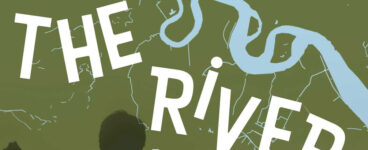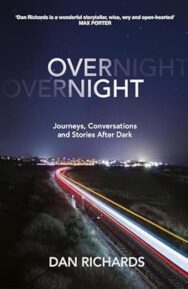‘Outside it’s overcast. Night is falling. The wind is getting up. Rain had been drumming on the roof of the covered walkway from the terminal out to the ship.’
Overnight is a celebration of all things nocturnal, of those who labour while the rest of us sleep, of nighttime wildlife, the stars, dreams and art. Through a series of personal journeys Dan Richards explores what the night means to a fascinating array of people, taking us from night terrors to the glow of watching the dawn break on the summer solstice. In this extract, Dan takes a night journey on a ferry in the far north of Scotland.
Overnight:
III: NIGHT FERRY
SUMMER: ABERDEEN TO SHETLAND, MAY 2022
You join me on the bridge of the MV Hjaltland in the middle of the dusky North Sea. The Hjaltland – Old Norse for ‘Shetland’ – is a roll-on-roll-off ferry, 125 metres long, 19.5 metres wide, with a gross tonnage of 11,720. Seven times a week she makes the trip to Shetland, carrying passengers, cars, livestock and freight the 216 miles north to Lerwick, arriving at 07:30 in the morning, having left Aberdeen at 19:00 the night before (17:00 if sailing via Orkney) – a vital link for the islands’ 23,000 inhabitants.
It’s 2 a.m., twilight, midsummer: simmer dim.* Calm seas, the ship belting north. Beneath us, five to six hundred souls are asleep. Before us, the sky still carries a whisper of light. The bridge is blacked out save the swirling radar screens and low-lit arrays of buttons and dials. The third mate sits in the captain’s chair – the captain (or ‘master mariner’) having retired to his cabin around 9 p.m. and the chief officer about midnight. Next to the mate sits the watchkeeper, a young able seaman (known as an ‘AB’) from Orkney chatting about the ‘coos’ on the family farm, but his words are hard to follow because ‘Orange Crush’ by R.E.M. is blasting and my eyes and imagination keep darting off to the lights and sky-scraping fires of the rigs flaring infernal ahead.
There’s something slightly uncanny about it all, folkloric maybe – the sleeping ferry steaming for Polaris across an apparently infinite sea, helmed by a taciturn old hand and a boy. The mate, who’s worked on ships around the globe but at some point shunned promotion and returned to home waters for his final years, favours the night shift for the autonomy and quiet it affords. He is here together with a teenager at the start of his career; talkative, keen to see the world and climb the ladder of life at sea, night and day.
Orcadian poet Edwin Muir described the Shetland dialect as ‘a mixture of Norse, Scots, and Irish’ – ‘a soft and musical inflection, slightly melancholy, but companionable, the voice of people who are accustomed to hours of talking in the long winter evenings and do not feel they have to hurry; a splendid voice for telling stories in.’1
I’m here to tell the story of the ferry in summer and winter, and the people who work on it.
Tonight the skies are clear and the sea smooth, tranquil. All the thunder comes from the ship – the pulse of her four engines several storeys below. R.E.M. finished, the riff to ‘Enter Sandman’ begins to build. The radars swirl, the far rigs burn.
Dream voyage.
WINTER: SHETLAND TO ABERDEEN, NOVEMBER 2022
The first thing I notice once back aboard MV Hjaltland is the print-out of the Met Office Shipping Forecast on the reception desk:
Wednesday 02 November 2022
Fair Isle: South-easterly severe gale force 9 expected later.
Wind: South-west 5 to 7 becoming cyclonic 7 to severe gale 9.
Sea state: Rough or very rough, occasionally moderate at first in east.
Weather: Showers.
Visibility: Good, occasionally poor.
I read it aloud to Helen, fellow voyager and radio producer. We’re here to make a programme about the Shetland–Aberdeen ferry for BBC Radio 4. Turns out we’ve chosen a wild night to do it. The Beaufort Wind Force Scale describes gale force 9 as a ‘strong/severe gale of 41–47 knots / 47–54mph / 75–88km/h / 20.8–24.4m/s with wave heights of 23–32ft / 7–10m. High waves,’ it helpfully states in case anybody was in any doubt, then: ‘dense streaks of foam along the direction of the wind; sea begins to roll; spray affects visibility.’**
Well, this will be fun, I say to Helen. She grins the sort of grin people grin at the dentist.
Outside it’s overcast. Night is falling. The wind is getting up. Rain had been drumming on the roof of the covered walkway from the terminal out to the ship. Given the dreadful forecast the ferry is sailing early. We arrived late and would have missed the crossing but for a fellow passenger at the deserted check-in desk, likewise late because the early sailing – though announced online and in the Shetland Times the day before – had caught him unawares. Unlike us, he has an urgent need to get to Aberdeen by morning, a medical appointment for something serious. The NorthLink ferry is a lifeline service, transporting the ill is absolutely its business, so the desk radios the ship and departure is paused and all three of us are escorted up the ramp and onboard, beneath the giant blue Norseman on the ferry’s side, huge hand pointing towards the horizon, into the storm. Into the night.
* * * * *
One of the first things we discover is that nobody knows who we are. This might sound diva-ish but is actually fairly vital in terms of making a radio programme. ‘Hello, we’re from the BBC.’ ‘Yes, we’ve been expecting you! Allow us to help you make radio magic during this tempest,’ is a very different scenario to ‘Hello, we’re from the BBC.’ ‘I see. Good for you. Now, if you’ll excuse me, I need to batten down these hatches. No, you can’t record or talk to anyone, no.’
Fortunately it turns out that Captain Stephen McPherson is master tonight; the same captain I’d met and befriended back in May. Then, the sea was mirror calm. This evening it promises a smashing riot of white horses all the way to Aberdeen.
Having asked if a message can be sent to the bridge, we walk out onto the rear deck. Below us the pale wake froths back towards Lerwick, Britain’s most northerly port and the crossroads of North Sea and North-east Atlantic shipping. It is worryingly peaceful in the shelter of Lerwick’s natural harbour but I know that we are shortly to pass Sumburgh Roost, an unforgiving tidal race rippling silver in the gap between Shetland and Fair Isle. Beyond that the sea would reveal its true character and, even as I think that, it feels like the wind rises and the ship begins to thump with a renewed sense of urgency, the thump growing more pronounced by the minute as the Hjaltland increases her speed and leaves the lights and shelter of Shetland behind.
*The night-long twilight found in the far north around midsummer, a beautiful phrase I discovered in the pages of Sally Huband’s marvellous book of island reckoning, renewal and beachcombing, Sea Bean.
** The Beaufort Wind Force Scale relates wind speed to observed conditions at sea or on land. The scale was devised in 1805 by the Irish hydrographer Francis Beaufort (later Rear Admiral), a Royal Navy officer, while serving on HMS Woolwich.
Overnight:
ALSO IN THIS ISSUE

 The River by Craig A. Smith
The River by Craig A. Smith
‘Seven ghosts had been visiting his dreams; some pleasant, some not so much.’

 Poems from Fierce Salvage: A Queer Words Anthology
Poems from Fierce Salvage: A Queer Words Anthology
‘For all my life, I’ve stuck to walking pace, / but here, here comes the first rush of speed.













